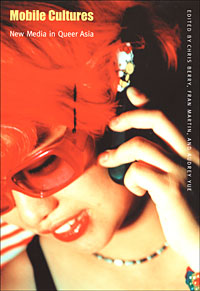 Mobile Cultures: New Media in Queer Asia
Mobile Cultures: New Media in Queer Asia
Edited by Chris Berry, Fran Martin, and Audrey Yue
Duke University Press
306 pages, $21.95
ANY SCHOLARLY BOOK with Hello Kitty on the cover is bound to turn my head. (Hello Kitty is a cartoon cat made into a chidren’s toy in 1974.) A bright little trinket of the Sanrio character with a red bow on her left ear dangles from a cell phone held to the ear of a young woman whose hair, glasses, and lipstick all match the hue of Hello Kitty’s bow. Llarissa Hjorth surveyed Tokyo residents about the ubiquitous practice of decorating cell phones with cute (“kawaii”) characters, and concludes that these characters, far from being asexual, offer a “space in which to negotiate taboo notions such as sexual identity.” Much like the Japanese concept of “ma,” or the space between words where meaning floats, cartoon character culture, according to Hjorth, occupies an in-between space that allows for the expression of a range of gender roles and sexualities.
Hjorth’s essay on the notion of cuteness in Japan is one among many gems in Mobile Cultures: New Media in Queer Asia, whose project is to address the ways in which new media (the Internet, cell phones, ’zines, and such) have facilitated the development of GLBT identities and cultures in Asia. Importantly, editors Berry, Martin, and Yue and the contributors do not see a simple, one-sided transmission of Western concepts of gay identity to the East. They place themselves in opposition to Dennis Altman, whom they see as implying a common gay consciousness and identity created by globalization or “Americanization.” I concur with the editors’ assessment of Altman’s position: while Altman recognizes that GLBT movements in non-Western countries will “develop identities and lifestyles different to those from which they originally drew their inspiration,” he leans heavily toward a homogenizing view of globalization. (Altman’s 1996 essay “On Global Queering” has been hotly debated in the pages of the Australian Humanities Review, where a handful of scholars, including editors of this book, weigh in.) Editors Berry, Martin, and Yue prefer Arjun Appadurai’s less homogenizing view of globalization as an exchange between the local and the global.
Mobile Cultures is divided into three main sections, the first of which deals primarily with the local appropriation of global technology or what the editors call “glocalization.” In this segment, Tom Boellstorff uses the metaphor of dubbing to argue that even though many Indonesians choose the words lesbi and gay to describe themselves, these terms are “not just ‘lesbian’ and ‘gay’ with a foreign accent” delivered by new media, but an “awkward fusion” of Indonesian and Western notions. Mark McLelland and Veruska Sabucco discuss Japanese manga (comics). McLelland focuses on the Internet’s role in expanding the visibility both of comics featuring boy-boy love and of transgendered men working in the sex industry. Sabucco examines Western women’s (mis)readings of manga. The second group of essays looks at how new media play a role in redefining local customs. Baden Offord looks at how gay Singaporeans have used the Internet to create a space for themselves not as “tainted” by “Western ideas of homosexuality” but as Singaporeans who don’t have to emigrate to the West to live a gay life. Sandip Roy closes this section with an examination of the Web’s role in reworking what it means to be “Indian” and “gay” in the Indian diaspora. The final set of articles deals with the regional transmission of knowledge and culture across New Asia and queer subversions of information control.
One might question the organization of these articles, but collectively they demonstrate the importance of empirical analysis of GLBT cultures in Asia. Such investigations are few and far between, as most treatments of lesbian and gay Asia that I have encountered are literary accounts: biographies, short fiction, and a few novels. Of course, some of the data gathered by the contributors are incomplete or scientifically insignificant due to the difficulty of working with sometimes very small or closed communities. Nonetheless, the book has begun the work of sociologically grounded research and provides more than a passing glimpse into gay Asia.
While the articles are generally quite engaging, the prose can be cumbersome. Take, for example, the following excerpts, one from the opening essay, the other from the final:
For these Indonesians, the prerevelatory period of sexual subjectivity is experienced locally; the local is the space of the not-lesbi or not-gay. The moment when “I knew that was me” has a spatial dimension: they enter not only a sexual self-narrative but a metapragmatics of scale for that narrative. The deictic “I knew that was me” is profoundly translocal, placing the self in a dialogic relationship with a distant but familiar Other.
E-sambal’s construction of its membership and the rice-accumulation strategies practiced by its members problematize the forces of regionality and globalization and support the structure of cybernetic rice as a linear and nonlinear system.
I’m taking bets on what “metapragmatics of scale for that narrative” or “rice-accumulation strategies” that “support the structure of cybernetic rice” means. Since a book’s first and last essays are usually the most frequently read, it is unfortunate that the ones in this volume sometimes use unnecessarily dense prose that might prevent readers from persevering. Please do persevere, though. Such opaque moments are rare, and the book has much to offer both scholars in an array of fields and aficionados of Asian culture.
Mimi Van Ausdall is a Ph.D. candidate (ABD) in the Department of English, University of Iowa.





